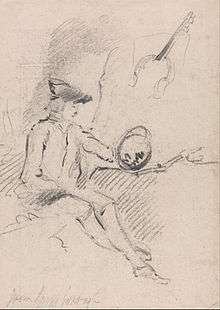Claude glass
_-_Le_Berger.jpg)

by Thomas Gainsborough
A Claude glass (or black mirror) is a small mirror, slightly convex in shape, with its surface tinted a dark colour. Bound up like a pocket-book or in a carrying case, Claude glasses were used by artists, travelers and connoisseurs of landscape and landscape painting. Claude glasses have the effect of abstracting the subject reflected in them from its surroundings, reducing and simplifying the colour and tonal range of scenes and scenery to give them a painterly quality.
They were famously used by picturesque artists in England in the late 18th and early 19th centuries as a frame for drawing sketches of picturesque landscapes.[1] The user would turn his back on the scene to observe the framed view through the tinted mirror—in a sort of pre-photographic lens—which added the picturesque aesthetic of a subtle gradation of tones. Thomas West in his A Guide to the Lakes (1778) explained "The person using it ought always to turn his back to the object that he views. It should be suspended by the upper part of the case…holding it a little to the right or the left (as the position of the parts to be viewed require) and the face screened from the sun."
The Claude glass is named for Claude Lorrain, a 17th-century landscape painter, whose name in the late 18th century became synonymous with the picturesque aesthetic, although there is no indication he used or knew of it or anything similar. The Claude glass was supposed to help artists produce works of art similar to those of Lorrain. William Gilpin, the inventor of the picturesque ideal, advocated the use of a Claude glass saying, "they give the object of nature a soft, mellow tinge like the colouring of that Master."
Claude glasses were widely used by tourists and amateur artists, who quickly became the targets of satire. Hugh Sykes Davies observed their facing away from the object they wished to paint, commenting, "It is very typical of their attitude to Nature that such a position should be desirable."[2]
In the 20th century, architect Mary Colter included Claude glasses (dubbed "reflectoscopes") in her Desert View Watchtower for the use of visitors viewing the Grand Canyon.[3]
See also
References
- ↑ "Claude Glass". Paintings & Drawings. Victoria and Albert Museum. Retrieved 2007-06-07.
- ↑ James Buzard (2002). "The Grand Tour and after 1660-1840," in The Cambridge Companion to Travel Writing. ISBN 0-521-78140-X
- ↑ Gerke, Sarah Bohl (July 8, 2010). "Nature, Culture and History at the Grand Canyon: Desert View Watchtower". Arizona State University. Retrieved March 16, 2014.
External links
- "Picture of a Claude glass". Victoria and Albert Museum. Retrieved 2007-06-07.
- "A demonstration of a Victorian Claude glass made by Elliott, London".
- "University of Windsor website about Claude glasses, and link to a Claude glass webcam".